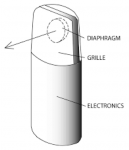I have an M-Audio Nova mic, which has a polar cardioid pattern. I know what a polar cardioid pattern is (I think) but I don't know how it fits on this microphone. I can picture the pattern on something like a Shure 58, but the Nova has two sides, not a front. Are both sides included equally? Are you supposed to sing/record at the front instead of the sides? And one of the advantages of a cardioid mic is rejection of noise in the other direction. What other direction? How do I point it away from an unwanted sound source?
If this is obvious and I'm just stupid, I apologize abjectly.
Mouse
If this is obvious and I'm just stupid, I apologize abjectly.
Mouse




